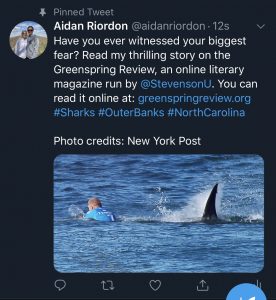
I think Twitter would be the most effective platform for my submission for the GSR. Twitter is my favorite social media platform and it is used by many college students. Although my primary audience is college students at Stevenson University, my secondary audience could be frequent beachgoers since my story takes place at the Outer Banks in North Carolina. When I was creating my social media post, I was debating between Twitter and Instagram. I decided to choose Twitter because of the type of content on the two platforms. When college students are scrolling through Instagram, they only want to see pictures. Usually, people go through Instagram much faster than other social media sites since they do not read much. Meanwhile, Twitter is full of all types of media, so people are more likely to read posts or click on a link that opens a new window with your writing. Another good feature of Twitter is that other users can retweet your post, which increases the number of people that will interact with my tweet.
There is no character or space limit for Twitter. However, no one wants to read a super lengthy tweet, so I think it is best to keep it short. Twitter allows you to include a picture or GIF along with a text caption. I think I should use an attention catching picture with a two sentence caption. The image will catch their attention, and then I will really draw them in with a personal question as a hook. Although you are not able to manipulate the font or color, I do not think it is necessary because I want to keep it simple. Furthermore, I think emojis may decrease my credibility, so I want to keep everything short, simple, and professional.
I think an image with a caption will work best. If I only used text, then I think it would get overlooked since there are so many tweets with just text on Twitter. If I used a video, then that would give away the plot of my story, which I do not want to do because I want people to read my story and be surprised. I think a professional photograph of a man next to a shark is the perfect image because it captures the viewer’s attention without spoiling the story. If I were to use a GIF, then I do not think that would capture their attention as much as a photograph.
I would post around 9 am on a Saturday morning. Many college students wake up and scroll through Twitter like it is the morning newspaper. I think I would get the most likes and comments by posting it on a Saturday morning since that is when many college students are active on Twitter. I do not want to post it on a weekday since most people still have online classes, which leads to a wide range of possible viewing times. I feel like Saturday morning is a safe time since everyone should be home to read their Twitter feed. With Twitter, you are also able to retweet your own post. Therefore, I could retweet it the following week around noon, which would be the second best posting time. This is because people usually have a lunch break around noon, so they are able to check their social media platforms. The last thing I would do is “pin” the tweet to my profile. This means that if someone views my profile, the tweet will always appear at the top. By doing this, I will increase my views even more.
